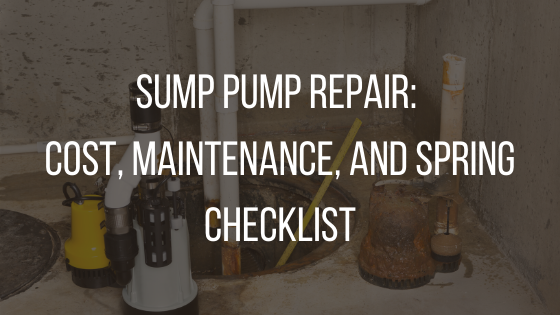
The best way to avoid a costly sump pump repair is by taking preventative measures to reduce the odds of it happening. Since sump pumps work on an automatic system, you may not realize if a unit is going out before it’s too late.
Between melting snow and frequent raining due to the fluctuating temperatures, sump pumps are most relied on during the springtime, also known as “sump season.” A sump pump is responsible for removing and moving water away from your home, and since it’s been estimated that 98% of all basements in the United States will experience water damage at some point, saving yourself from an expensive hassle with a little bit of extra work is well worth it.
How to Avoid a Sump Pump Repair
No one wants to go through a sump pump repair, so the best thing you can do is preventative maintenance checks starting in March to reduce your chances of it happening. If you can, it’s even better to run through this checklist at least two times per year.
If you’ve never done this type of annual check, or you are unsure of where to begin, not to worry. Our sump pump maintenance checklist has you covered.
Sump Pump Maintenance Checklist
- Check for Debris – Simply start by examing the area around your sump pump. It’s not uncommon for the sump pump pit to accidentally come in contact with small items that may interfere with the float mechanism.
- Examine the “Check” Valve – Where is the arrow pointed? An arrow pointed toward the pump indicates that it’s installed incorrectly, which will result in water flowing back into the sump pump while turned off.
- Watch the Weep Hole – If possible, every three to four months you should clean the weep hole with a tiny object. Just be careful not to break off anything inside of it.
- Inspect the Impeller – This small filter should be bolted to your sump pump. If your pump has been making a whining noise or even stops running, the impeller may be clogged.
- Smell Check – There’s always going to be a small amount of water in the trap, but if there is a persistent odor it might be a sign of it sitting too long. Adding some water mixed with a cleaning agent, such as bleach, to the basic should cause the sump pump to engage and cycle the water.
- Power and Backup Source – When is the last time you checked to ensure the power is connected to your sump pump? Don’t be caught in the middle of a large rainstorm only to find your pump is malfunctioning. Installing a backup power source, like a generator, will give you some peace at mind in case you are left without electricity.
We Can Help! Connect with Handyman Connection Today.
Handyman Connection has decades of experience serving and assisting customers with all of their home maintenance needs. If you have any questions about sump pumps or want an estimate, reach out today!
